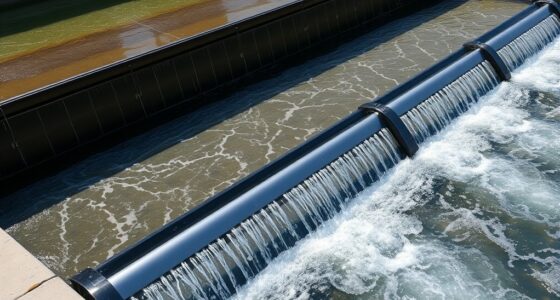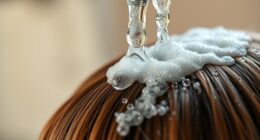To manage water chemistry in overflow systems, you need to guarantee proper make-up water quality and control dilution. This involves monitoring key parameters like pH, alkalinity, and dissolved solids, while using filtration and chemical treatments to address impurities. Reusing or recycling water can reduce fresh make-up needs, but requires careful treatment to prevent scaling and corrosion. If you keep these practices in mind, you’ll understand how to optimize your system’s chemistry and prevent issues down the line.
Key Takeaways
- Proper make-up water maintains system levels and stabilizes water chemistry to prevent corrosion and scaling.
- Monitoring parameters like pH, alkalinity, TDS, and mineral levels ensures water quality and system integrity.
- Treatment techniques such as filtration, chemical dosing, and reverse osmosis remove impurities and control contaminants.
- Controlling pH, reducing oxygen, and adding inhibitors prevent corrosion and protect system materials.
- Recycling and dilution with treated water reduce fresh water demand and help maintain optimal water chemistry.
Understanding the Role of Make-Up Water in Overflow Systems

Make-up water plays a vital role in maintaining the proper balance of water in overflow systems. Without it, water levels can drop below safe operating limits, risking equipment damage or system failure. When water evaporates or is lost through leaks, make-up water replenishes the system to keep water chemistry stable. You need to ensure the make-up water quality is appropriate, as contaminants can cause corrosion, scaling, or biological growth. Proper control of make-up water input helps maintain consistent pH, alkalinity, and mineral levels. This balance is crucial for efficient system operation and longevity. By monitoring and adjusting the make-up water flow, you prevent fluctuations that could lead to costly repairs or inefficiencies. Ultimately, managing make-up water is key to preserving the integrity of your overflow system. Additionally, ensuring the correct water chemistry helps optimize system performance and prevents potential damage caused by improper mineral levels.
Key Water Chemistry Parameters to Monitor

Monitoring key water chemistry parameters is essential to guarantee your overflow system operates efficiently and remains protected from damage. You should regularly check pH levels to prevent corrosive or scale-forming conditions. Maintaining appropriate alkalinity helps stabilize pH and minimizes corrosion risks. Total dissolved solids (TDS) indicate the concentration of dissolved substances, which can impact system performance. Monitoring conductivity provides a quick assessment of TDS levels. Keep an eye on calcium and magnesium levels to prevent scaling, especially in high-temperature areas. Additionally, tracking chlorides and sulfates helps avoid corrosive environments. Regular testing ensures you catch anomalies early, allowing for timely adjustments. Staying vigilant with these parameters safeguards your system’s integrity, reduces maintenance costs, and prolongs equipment lifespan. Incorporating water chemistry knowledge into your regular maintenance routine can further optimize system performance and longevity.
Sources and Quality of Make-Up Water

The quality of the water you supply to your overflow system directly impacts its performance and longevity. Your make-up water sources can vary, including municipal supplies, groundwater, surface water, or recycled water. Each source has distinct characteristics that influence system chemistry. Municipal water often contains disinfectants and treatment chemicals, which can affect corrosion and scaling. Groundwater may have high mineral content, such as calcium or magnesium, leading to scale buildup. Surface water might carry organic matter or particulates, increasing the risk of fouling. Recycled water can contain residual contaminants or nutrients. Ensuring consistent quality from your source is vital. You should evaluate the source’s chemical makeup and consider pretreatment options if necessary. Proper source management helps maintain system integrity and reduces maintenance needs. Source water quality plays a crucial role in preventing scaling, fouling, and corrosion issues within your overflow system.
Impact of Impurities in Make-Up Water

Impurities in water can substantially compromise the efficiency and durability of your overflow system. When contaminants like minerals, organic matter, or chemicals enter your make-up water, they can cause scaling, corrosion, or fouling of system components. Scale buildup from dissolved salts and minerals reduces heat transfer efficiency and restricts flow, leading to increased energy consumption. Organic impurities can promote biological growth, resulting in biofouling that hampers system operation. Chemicals such as chlorides or sulfates may accelerate corrosion of pipes and equipment. These issues not only decrease performance but also increase maintenance costs and downtime. To keep your system running smoothly, it’s essential to monitor and limit impurities in the make-up water, ensuring it is as clean as possible before entering your overflow system. Proper water treatment methods can help remove or reduce these impurities, protecting your system’s longevity and efficiency.
Techniques for Dilution and Water Treatment

Effective dilution and water treatment methods are essential for minimizing impurities and maintaining superior overflow system performance. To achieve this, you should regularly analyze your make-up water to identify contaminants and adjust treatment accordingly. Using filtration helps remove suspended solids, while chemical dosing can neutralize corrosive elements and prevent scale formation. For organic impurities, consider biological treatments or activated carbon filtration. Dilution techniques involve blending make-up water with recycled water or other sources to dilute harmful substances to safe levels. Implementing reverse osmosis can effectively remove dissolved salts and metals. Additionally, understanding local divorce statistics and regional resources can inform your water management strategies. Consistent monitoring and adjusting treatment protocols ensure impurities stay within acceptable limits. Properly applied, these techniques protect your system from damage, extend equipment lifespan, and optimize overall performance.
Managing Ph Levels for System Stability

Maintaining proper pH levels is essential for ensuring your overflow system operates smoothly and remains corrosion-free. When pH drifts too low, acids can corrode metal components, causing leaks and equipment failure. Conversely, high pH levels can lead to scaling and deposits that impair flow and heat transfer. To manage pH, regularly test your water and adjust as needed using pH modifiers like acids or bases. Small, consistent adjustments are more effective than large swings. Keep records of pH readings to identify trends and prevent sudden shifts. Using buffers can help stabilize pH over time. Remember, maintaining a balanced pH not only protects your system but also optimizes its efficiency and longevity. Regular monitoring and prompt adjustments are key to system stability.
Controlling Hardness and Scaling Potential

Controlling hardness and scaling potential is crucial to prevent mineral deposits that can clog pipes and reduce heat transfer efficiency. Hardness mainly comes from calcium and magnesium ions in your water. To manage this, consider using water softening methods like ion exchange resins that replace calcium and magnesium with sodium ions. Regularly monitor your water’s hardness levels to adjust treatments as needed. Pre-treatment options, such as chemical inhibitors, can also prevent scale formation. Maintaining proper flow rates and temperature controls reduces the likelihood of mineral deposits settling out. Keep detailed records of your water chemistry to identify trends and optimize your control strategies. As the Private Placement Equity Market continues to evolve, implementing effective water chemistry management can help protect equipment investments and ensure system longevity. By actively managing hardness, you ensure your system runs smoothly, with fewer maintenance issues and improved efficiency.
Corrosion Prevention Strategies

To prevent corrosion in overflow systems, you need to implement strategies that minimize the water’s corrosive tendencies and protect metal surfaces. This involves controlling pH levels, reducing dissolved oxygen, and adding corrosion inhibitors. Maintaining a slightly alkaline pH (around 8) helps slow metal deterioration. Using corrosion inhibitors like phosphates or silicates forms a protective film on metal surfaces. Monitoring oxygen levels is essential because dissolved oxygen accelerates rust. Additionally, selecting corrosion-resistant materials, such as stainless steel or coated metals, can provide extra protection. Here’s a quick overview: corrosion prevention strategies
Strategies for Water Reuse and Recycling

You can improve your overflow system by recycling water sources to reduce demand. Implementing effective contaminant control methods guarantees recycled water stays clean and safe. Using advanced treatment technologies helps optimize reuse and maintain water quality over time. Additionally, establishing regulatory compliance measures ensures that your water reuse practices align with current legal standards and industry best practices.
Recycling Water Sources
Recycling water sources is a critical strategy for maintaining efficient overflow system operations and promoting sustainable water management. By reusing water within your facility, you reduce the demand for fresh make-up water, lowering costs and conserving resources. Implementing closed-loop systems allows you to capture and reuse water from process or cooling operations, minimizing waste discharge. It’s important to assess the quality of recycled water to guarantee it meets system requirements without introducing contaminants. Proper treatment methods, such as filtration or chemical adjustment, can enhance water quality for reuse. Recycling not only helps maintain consistent water chemistry but also supports environmental goals by decreasing overall water consumption and reducing the strain on local water sources. Effective reuse strategies are essential for long-term system reliability and sustainability. Reliable water management practices play a crucial role in ensuring that recycled water remains suitable for reuse while safeguarding system integrity.
Contaminant Control Methods
How can effective contaminant control strategies guarantee safe and sustainable reuse of water in overflow systems? By implementing proper control methods, you prevent harmful substances from accumulating, assuring water quality remains within safe limits. This involves identifying potential contaminants like oils, solids, or chemicals and establishing control points to minimize their entry. Regular monitoring helps you detect issues early, allowing quick adjustments. Using physical barriers, such as screens or filters, can trap debris before it contaminates the water. Additionally, controlling sources of contamination at the origin—like equipment leaks or runoff—reduces risks downstream. Noise reduction technology can also play a role in minimizing vibrations that may loosen debris, contributing to cleaner water. These strategies create a safeguard that maintains water clarity and purity, supporting sustainable reuse. Proper contaminant control not only protects equipment but also ensures the health and safety of the entire overflow system.
Efficient Treatment Technologies
Implementing efficient treatment technologies is essential for maximizing water reuse and recycling in overflow systems. You should evaluate options like membrane filtration, advanced oxidation, and biological treatment to remove contaminants effectively. Membrane processes, such as ultrafiltration or reverse osmosis, can eliminate suspended solids, bacteria, and dissolved impurities, ensuring water quality. Advanced oxidation methods, like UV or ozone treatment, break down organic pollutants and pathogens. Biological treatments, including biofilters or bioreactors, leverage microorganisms to degrade organic matter naturally. Combining these technologies can optimize treatment efficiency, reduce chemical use, and lower operational costs. By selecting the right combination, you enhance water quality, promote sustainability, and minimize reliance on fresh water sources. Properly implemented, these strategies support the long-term success of overflow system management.
Regular Testing and Maintenance for Optimal Performance

To keep your overflow system running smoothly, you need to regularly test the water and check chemical levels. Routine water sampling helps identify issues early, so you can address them before they worsen. Don’t forget scheduled maintenance checks to guarantee everything stays in peak condition.
Routine Water Sampling
Regular water sampling is essential to guarantee your overflow system operates efficiently and remains free of harmful buildup. By consistently testing your water, you can catch potential issues early and maintain ideal conditions. Here’s what you should focus on:
- Collect samples at regular intervals to track water quality trends.
- Use clean containers to avoid contamination.
- Document test results for future reference.
- Adjust your make-up water and dilution strategies based on findings.
This routine helps you identify changes in water chemistry before they affect system performance. Regular sampling ensures you stay proactive, keep chemical levels balanced, and prevent costly repairs or downtime. Staying consistent with sampling is key to maintaining a healthy, efficient overflow system.
Monitoring Chemical Levels
Consistently monitoring chemical levels in your overflow system helps you maintain ideal water quality and prevent potential issues. Regular testing of parameters like pH, alkalinity, and dissolved solids allows you to catch imbalances early. Use reliable test kits or digital meters to get accurate readings. Keep detailed records of each test to identify trends over time. If levels drift outside recommended ranges, adjust your make-up water or chemical additions accordingly. Maintaining proper chemical balance prevents corrosion, scaling, and bacterial growth, ensuring your system operates efficiently. Remember, consistent monitoring is essential for early detection of issues before they escalate. By staying vigilant and proactive about chemical levels, you safeguard your system’s performance and extend its lifespan.
Scheduled Maintenance Checks
Have you scheduled routine maintenance checks to keep your overflow system running at peak performance? Regular inspections prevent issues and ensure water chemistry stays balanced. Here’s what you should do:
- Check chemical levels and adjust as needed to prevent corrosion or scaling.
- Inspect the make-up water and dilution systems for leaks or blockages.
- Test water pH and conductivity to confirm proper chemical balance.
- Clean filters and strainers to avoid buildup that can affect flow and chemistry.
Perform these checks weekly or as recommended by the manufacturer. Keeping a maintenance log helps track trends and identify potential problems early. Consistent maintenance minimizes downtime, prolongs equipment life, and maintains ideal water quality. Staying proactive ensures your overflow system operates smoothly and efficiently.
Frequently Asked Questions
How Do Seasonal Changes Affect Make-Up Water Requirements?
Seasonal changes directly impact your make-up water needs because temperature fluctuations alter evaporation rates and system losses. During hot, dry seasons, you’ll likely require more make-up water to compensate for increased evaporation and drift. Conversely, cooler months reduce evaporation, lowering your demand. You should monitor system levels closely and adjust make-up water accordingly to maintain ideal operations, prevent corrosion, and ensure water quality remains consistent year-round.
What Are the Environmental Impacts of Water Dilution in Overflow Systems?
Did you know that improper water dilution can lead to a 30% increase in pollutant concentrations? When you dilute overflow water, you might think you’re reducing environmental harm, but it can actually spread contaminants further, affecting local ecosystems and water quality. This process can harm aquatic life, degrade water sources, and increase treatment costs. So, managing dilution carefully is essential to minimize environmental impacts and protect natural resources.
How Does Water Chemistry Influence System Lifespan and Efficiency?
Your water chemistry directly affects your system’s lifespan and efficiency. If you maintain proper pH levels, control mineral content, and prevent corrosion, your equipment operates smoothly and lasts longer. Conversely, poor water quality leads to scaling, corrosion, and fouling, which reduce efficiency and cause costly repairs. Regular testing and treating your water help optimize performance and extend your system’s life, saving you time and money.
What Are Cost-Effective Methods for Water Treatment and Reuse?
You can save costs by implementing simple methods like reverse osmosis or ion exchange to treat water effectively. Reusing treated water within your system diminishes fresh water intake, lowering expenses. Regularly maintaining and monitoring your treatment equipment guarantees efficiency and prevents costly repairs. Additionally, using chemical dosing wisely controls scale and corrosion, extending equipment lifespan. These steps help you maintain system performance while keeping treatment costs manageable.
How Can Automation Improve Water Chemistry Management?
Imagine a control panel glowing softly as sensors detect changes in water quality. Automation streamlines your water chemistry management by instantly adjusting chemical dosing, maintaining ideal levels, and preventing issues. It reduces manual work, minimizes human error, and guarantees consistent water quality. You can set alerts for unusual conditions, so you’re always informed. Overall, automation keeps your system running smoothly, saving you time and resources while enhancing safety and efficiency.
Conclusion
Think of your overflow system as a delicate dance partner—without the right water chemistry, it’s bound to trip over impurities and scale. By carefully monitoring make-up water, controlling impurities, and embracing recycling, you keep the performance smooth. Skimp on testing, and you’ll be choreographing a disaster—like trying to waltz with concrete blocks. Stay vigilant, stay prepared, and let your system glide gracefully through the water’s chaos.










